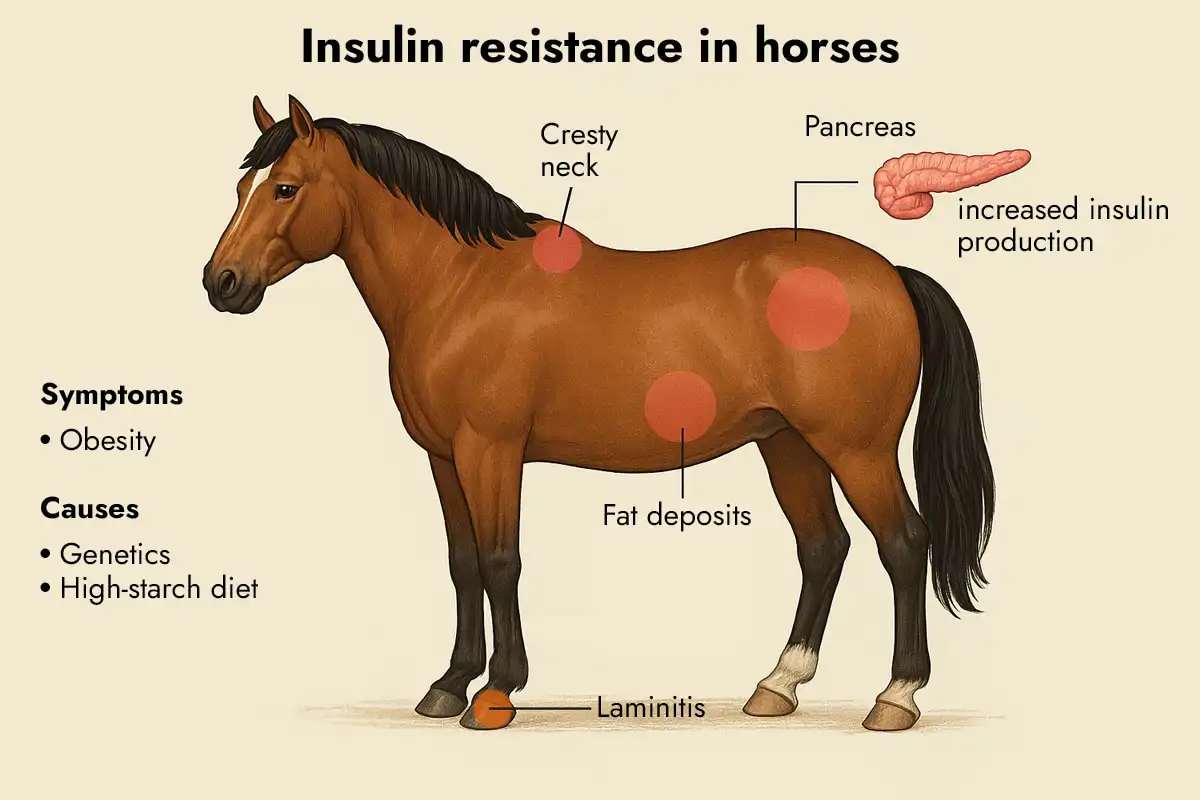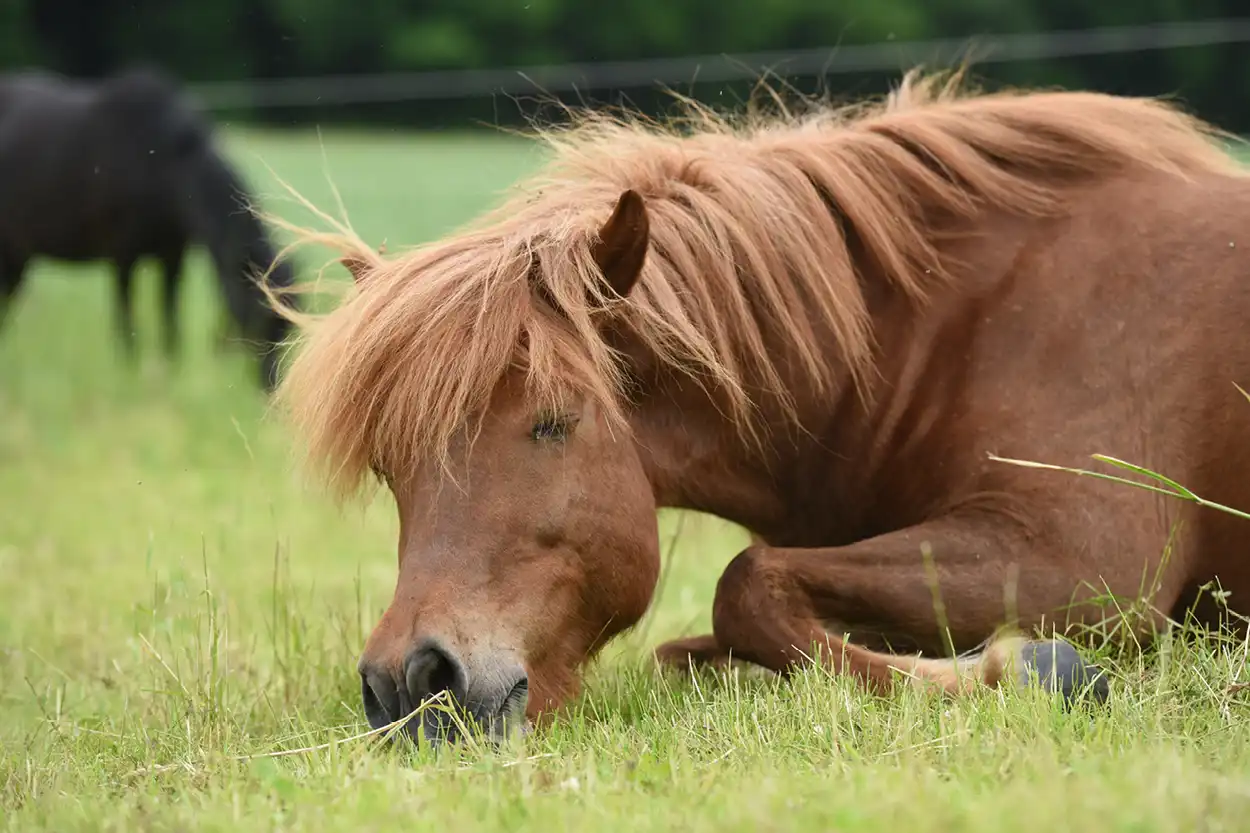Insulin Resistance (IR) in Horses, Ponies, and Donkeys – precursor or form of diabetes
A Leading Cause of Laminitis and Equine Metabolic Syndrome (EMS)
Horses, ponies, and donkeys that gain weight easily – despite limited feed intake – may be suffering from insulin resistance (IR) or Equine Metabolic Syndrome (EMS). These metabolic disorders are becoming increasingly common and pose serious health risks, especially due to their strong link to laminitis, a painful and potentially life-threatening hoof condition.
What is Insulin Resistance?
Insulin resistance is a metabolic disorder where the body’s cells (particularly fat and muscle cells) become less responsive to the hormone insulin, which is responsible for moving glucose from the blood into cells. In IR cases, the pancreas compensates by producing more insulin, resulting in chronically elevated insulin levels—a condition harmful to internal organs and hoof health.
Connection to Laminitis and EMS
Prolonged high insulin levels can interfere with the blood flow in the hoof, leading to laminitis. IR is therefore a key trigger for this dreaded disease. It also contributes to the development of EMS, a condition defined by IR, regional fat deposits, and recurrent laminitis.
Breeds at Higher Risk
While any equine can develop IR, certain breeds are more genetically predisposed, particularly the so-called "easy keepers":
- Shetland Pony
- Welsh and New Forest Ponies
- Haflinger
- Gipsy Cob / Tinker
- Friesian
- Belgian Draft
- Donkeys
Clinical Signs
- Weight gain despite restricted feeding
- Fatty deposits along the crest, shoulders, rump
- Lethargy or signs of (mild) laminitis
- Classic “cresty” appearance
Diagnosis: Blood Testing
- Fasting sample after 6–12 hours without food
- Insulin > 20 µL (Microliter)/L with normal glucose = likely IR
- If results are inconclusive: perform an oral glucose tolerance test
Summary
- IR is a serious metabolic condition that increases the risk of laminitis
- Early detection is critical, especially in predisposed breeds
- Regular blood tests are highly recommended for at-risk animals
Obesity in Horses
Obesity, also known as being overweight or fat accumulation in horses, is a growing problem caused by an oversupply of energy-rich food combined with insufficient exercise. Fat tissue is not only an energy store but can also be hormonally active and trigger inflammatory processes, potentially leading to metabolic disorders such as Equine Metabolic Syndrome (EMS) and laminitis.
Causes:
- Excessive Feeding: A year-round abundant supply of feed, especially concentrates and treats, with a simultaneously low energy requirement due to lack of exercise, promotes obesity.
- Lack of Exercise: Too little turnout, minimal physical work, or movement restrictions (e.g., stall rest) can result in a positive energy balance and thus lead to overweight.
- Breed Predisposition: Easy-keeper pony and horse breeds, whose metabolism is adapted to sparse feed, are more frequently affected.
- Feeding Errors: Oversupply with energy-rich feed, misinterpretation of workload, or improper management can all contribute to weight gain.
Consequences:
- Metabolic Disorders: Obesity can be associated with reduced insulin sensitivity, leading to insulin resistance, EMS, and laminitis.
- Increased Risk of Laminitis: Overweight horses are particularly prone to laminitis, a painful inflammation of the hoof laminae, which may be triggered by metabolic disorders or mechanical overload.
- Reduced Performance Capacity: Obese horses often show decreased performance and endurance.
- Higher Risk of Other Illnesses: Overweight horses are more susceptible to circulatory problems, respiratory diseases, and colic.
Recognizing Obesity:
- Visible Fat Deposits: Fat accumulation on the neck (cresty neck), tailhead, shoulders, croup, or the entire body is a clear sign of overweight.
- Ribs No Longer Easily Palpable: In horses of normal weight, the ribs are easy to feel. In overweight horses, they are covered by fat deposits.
- Altered Body Contour: The neck may be strongly arched, and fat pads can form in various body areas.
- Body Condition Scoring (BCS): An evaluation system for assessing a horse’s nutritional status based on fat deposits at specific body locations.
Treatment:
- Reduction of Feed Ration: A diet should consider the horse’s individual needs and be developed in consultation with a veterinarian to avoid metabolic disorders.
- Sufficient Exercise: Regular, ideally daily, exercise supports weight loss and promotes the horse’s health.
- Comprehensive Feed Control: The quantity and composition of feed must be precisely adjusted to achieve a negative energy balance.
- Avoidance of Crash Diets: Weight loss that is too rapid can disrupt fat metabolism.
Prevention:
- Balanced Feeding: Feed rations tailored to the horse’s energy requirements are essential.
- Regular Exercise: Ensure sufficient movement and pasture time to prevent overweight.
- Review of Breed Predisposition: Easy-keeper breeds require special attention to adapted feeding and exercise routines.
>>> Birk Super Feet




